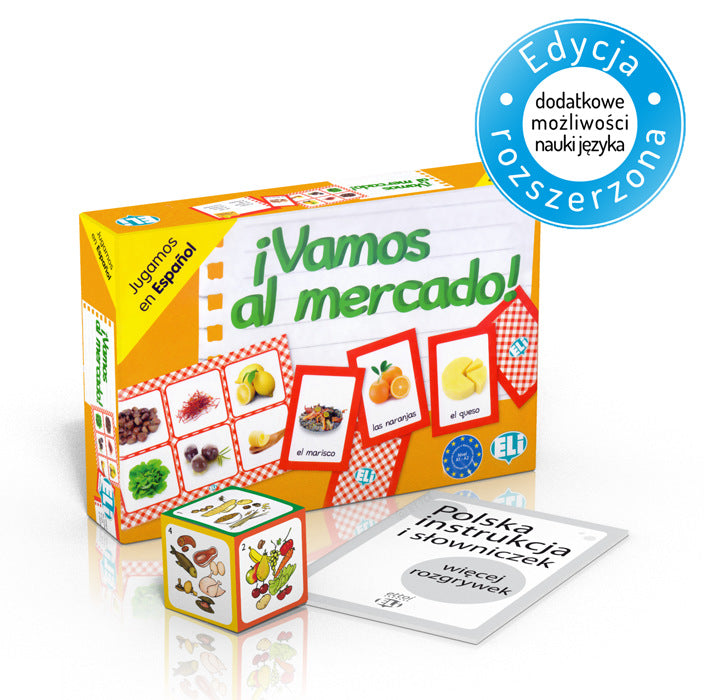Product Details
- Binding: BOX
- ISBN-13: 9788853613707
- Language: Spanish
- Publisher: ELI
- Publishing Date: 2012
- Subtitle: Games
- Subject: Spanish
- Weight: 400g
About The Book
The game offers the possibility of playing at A1, A2 or higher levels (depending on the game variant chosen by the teacher).
Players have at their disposal 36 boards with sample shopping lists on one side and photos of various groceries on the other side. The photos of food products with their names are also placed on the enclosed deck of 66 cards (these cards, apart from their original function, can also serve as typical flashcards for learning vocabulary).
Variant of the game in the bingo convention: Each of the game participants receives one or more boards with photos of various food products. Then the person leading the game draws cards one by one and, depending on the difficulty of the game, shows pictures of food products or just reads their names aloud to other game participants, whose task is to find appropriate equivalents on their board / boards. The winner is the player who first matches all names or illustrations of products from his board / boards to the displayed images or read names. Depending on the level of knowledge of the vocabulary and language skills of the players, the following variants of matching the cards to the boards are possible:
- product name
- product name - photo - photo
- product name - photo
- photo - product name.
Shopping game : Each game participant receives one board with a shopping list and several cards with photos of various food products. The player's task is to complete cards with all the groceries on his shopping list. To this end, the first player asks his neighbor a question about the selected food product that he wants to buy (for example: ¿Tienes leche? ). If the asked participant of the game has a card with this product, the answer is yes, Sí, tengo (leche). and gives the card to the questioning person, and if there is no such card, he replies: No, no tengo (leche). Then the questioned person asks another player about the selected food product. Each food product can be asked many times and many people, but once received a card with a food product must be given to another player who will ask for it. The winner is the player who first "buys" all the groceries on his shopping list.
Other proposed ways of using the game, described in detail in the attached instructions :
-laying a food pyramid using cards with pictures of food products,
-stelling about your own or other people's eating habits,
-playing "what can be bought in what store",
-playing with using expressions such as:little, a lot, a little, a kilo, slice, bunch, wrapping, box, piece, bottle, serving, and so on .
-games searching for missing ingredients necessary to prepare various dishes,
-games composing recipes from ingredients from the drawn cards,
Language objectives :
-learning names of food products,
-learning countable and uncountable nouns,
-learning vocabulary and expressions related to making shopping, -
independent building of an oral expression.
Cultural goals : -
learning about the culture related to food and shopping
Age range : children from 8 years of age, adolescents, adults
Application: The game is used both during classes at school and at home (games with friends and family, or private Spanish lessons).
Additional benefits: The language game ¡Vamos al mercado! improves mental skills such as memory, concentration and perceptiveness, promotes effective remembering and teaches activity and healthy competition, and its ludic character helps to establish social relationships with other participants of the game and has a positive effect on reducing the distance between the student and the teacher.
Additional cube: The game has been enriched with new variants of games thanks to the use of an additional cube extending the educational scope of the game.
Extended manual: The game comes with an extensive manual in Polish containing:
- methodological introduction for teachers, parents and the players themselves,
- extensive game scenarios,
- proposals for educational games and exercises,
- a practical glossary of the names of food items used in the game for copying, together with a translation into Polish and a phonetic transcription.
The instruction in Polish is also a convenience for people who do not know the foreign language sufficiently to read the original, foreign-language version of the instruction, as well as the ability to independently manage language and educational games with children or peers.
The game was developed on the basis of the criteria of the European System for the Description of Languages (Marco común europeo de referencia para las lenguas) - level A1-A2.













